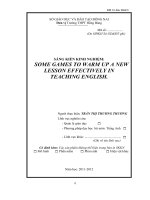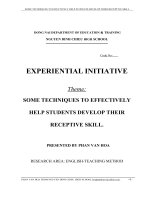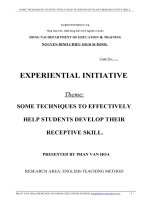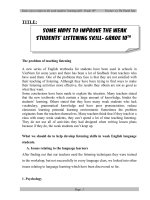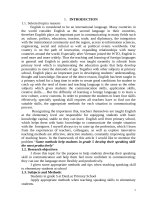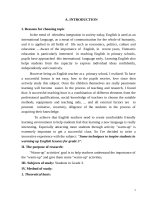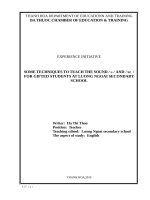skkn SOME TECHNIQUES TO EFFECTIVELY HELP STUDENTS DEVELOP THEIR RECEPTIVE SKILL
Bạn đang xem bản rút gọn của tài liệu. Xem và tải ngay bản đầy đủ của tài liệu tại đây (389.42 KB, 36 trang )
SOME TECHNIQUES TO EFFECTIVELY HELP STUDENTS DEVELOP THEIR RECEPTIVE SKILL
DONG NAI DEPARTMENT OF EDUCATION & TRAINING
NGUYEN DINH CHIEU HIGH SCHOOL
Code No: .....
EXPERIENTIAL INITIATIVE
Theme:
SOME TECHNIQUES TO EFFECTIVELY
HELP STUDENTS DEVELOP THEIR
RECEPTIVE SKILL.
PRESENTED BY PHAN VAN HOA
RESEARCH AREA: ENGLISH-TEACHING METHOD
PHAN VAN HOA FROM NGUYEN DINH CHIEU HIGH SCHOOL
-0-
SOME TECHNIQUES TO EFFECTIVELY HELP STUDENTS DEVELOP THEIR RECEPTIVE SKILL
Academic Year: 2011- 2012
APPENDIX
1.Reason for choosing the theme.
Page 2
2.Ways to conduct the theme.
Page 3
3.Introducing some types of receptive skill tasks .
Page 3
4.Introducing some techniques to deal with the receptive skill tasks. Page 4
Technique 1
Page 4
Technique 2
Page 9
Technique 3
Page 12
Technique 4
Page 15
Technique 5
Page 19
Technique 6
Page 22
5.Efficiency gaining
Page 27
6.Statistical tables
Page 27
7.Experience lesson
Page 28
8.Conclusion
Page 29
9.Summary
Page 30
10.Reference
Page 33
PHAN VAN HOA FROM NGUYEN DINH CHIEU HIGH SCHOOL
-1-
SOME TECHNIQUES TO EFFECTIVELY HELP STUDENTS DEVELOP THEIR RECEPTIVE SKILL
I. REASON FOR CHOOSING THE THEME:
Learning a foreign language,as we all know,requires language learners to
learn enough four skills:Listening,Speaking,Reading and Writing.Listening and
reading are called a receptive skill meanwhile speaking and writing are considered
a reproductive one.
For teaching and learning foreign languages in general and English in
particular,listening and reading skills are widely used along with other skills like
speaking and writing. But in reality,these are two significant skills to get
information and most regularly used in communicative activities in daily life.It
can't be denied that bad listening and reading skills can result in a breakdown in
communication.As a result,listening and reading are regarded as a basic
communication factor. A language learner with no other option must improve
these two skills if he wishes to be successful in communication.
At present,most school children are still shy and passive when learning
English while others seem not to be interseted in studying and aren't aware of the
importance of English learning.For the most part,they learn English because it is
one of their subjects at school.More importantly,school children haven't set
realistic goals for their own learning. Instead ,they only take a course in English
for exams and have no effective ways of learning. But how can we teachers help
language leamers,especially school children improve their receptive skills?.That's
the reason why I have selected this theme:
SOME TECHNIQUES TO EFFECTIVELY HELP STUDENTS
IMPROVE THEIR RECEPTIVE SKILL .
PHAN VAN HOA FROM NGUYEN DINH CHIEU HIGH SCHOOL
-2-
SOME TECHNIQUES TO EFFECTIVELY HELP STUDENTS DEVELOP THEIR RECEPTIVE SKILL
II. WAYS TO CONDUCT THE THEME:
1.Basis Of Reasoning.
Basing on many basis like goals,contents and methods of teaching and
learning a foreign language,the ability to use it and its role.At the same time, some
techniques of teaching and learning receptive skill for English are put forward. In
order to have an effective receptive skill-teaching period,it is required that a
teacher be aware of the significance of improving this skill for students as well as
provide them with some essential techniques to deal with the tasks related to the
skill.Furthermore,through this theme,a teacher can have an overall view and
systematize the techniques of teaching the receptive skill in an effective way.
It is hoped that the techniques having been mentioned in this report will bring
about teachers along with students several benefits in teaching and learning
English in general and listening and reading skills in particular.
2.Contents,solutions to complement the theme.
Following are some basic techniques that assist students develop their
receptive skill effectively.I do believe that if teachers know how to apply these
techniques fully and flexibly,they certainly will help students promote
positiveness,initiative and creativity of students of all levels while teaching
listening and reading skill.In addition,the very techniques create an exciting
atmosphere of studying for the whole class,shorten the amount of time doing tasks
and listening and reading -teaching period really become more effective than ever.
A.Introducing some types of receptive skill tasks applied by this topic.
Listening and reading tasks in English textbooks mainly focus on the
PHAN VAN HOA FROM NGUYEN DINH CHIEU HIGH SCHOOL
-3-
SOME TECHNIQUES TO EFFECTIVELY HELP STUDENTS DEVELOP THEIR RECEPTIVE SKILL
following types:
1. True / false Statements.
2.Multiple choice.
3.Listening/Reading comprehension questions.
4.Gap-filling exercises (with or without given words).
5.Matching exercises ....
B.Introducing some techniques to deal with these above-mentioned tasks.
Technique 1: Reading /Listening To Answer The Questions ,To Decide True
Or False Statements ,To Choose The Best Option ...
a.For reading comprehension tasks:
-First, Ss should skim the statements or questions given ... to understand
them.As Ss do this, they:
* Underline the key words or phrases to decide which information
they need to find in the text.
* Look for question words like "why" indicates Ss should read for
specific things like a reason.
- Then, they should go back to the passage and locate the key words/
phrases in the passage with a marker or a pencil.
-Finally,Ss should read around the key words/ phrases carefully to
find the answer.
Types of reading comprehension questions include:
Read the passage. Then answer the questions.
Read the text. Then answer the questions that follow.
Read the article to find answers to the following questions.
Read the passage. Then decide whether the following statements are
True(T) or False(F).
Read the passage. Then decide whether the following statements are true
(T) or false (F) or not mentioned (NM) in the reading passage. Then choose the
PHAN VAN HOA FROM NGUYEN DINH CHIEU HIGH SCHOOL
-4-
SOME TECHNIQUES TO EFFECTIVELY HELP STUDENTS DEVELOP THEIR RECEPTIVE SKILL
best option(answer).
Find the words or phrases in the text which have the following
definitions/meanings.
Read the passage. Then find out who did each of the followings.
Read the passage. Then complete the sentences, using the information
from the passage.
Read the text. Then match the headings to the paragraphs.
Read and find the evidence in the text to support these statements ...
The following example illustrates the above- mentioned technique.
Unit 4:
Volunteer Work
A. Reading (Page 46) English 11
Read the passage and then do the tasks that follow.
Each nation has many people who voluntarily take care of others. For
example, many high school and college students in the United States often spend
many hours as volunteers in hospitals, orphanages or homes for the aged. They
read books to the people in these places. Sometimes the students just visit them,
play games with them or listen to their problems.
Other young volunteers work in the homes of sick or old people. They
clean up their houses, do their shopping or mow their lawns. For boys who no
longer have fathers, there is a voluntary organization called Big Brothers. College
students take these boys to baseball games and help them to get to know things
that boys usually learn from their fathers.
Some high school students take part in helping disadvantaged or
handicapped children. They give care and comfort to them and help them to
overcome their difficulties. Young college and university students participate in
helping the people who have suffered badly in wars or natural disasters. During
summer vacations, they volunteer to work in remote or mountainous areas to
provide education for children.
PHAN VAN HOA FROM NGUYEN DINH CHIEU HIGH SCHOOL
-5-
SOME TECHNIQUES TO EFFECTIVELY HELP STUDENTS DEVELOP THEIR RECEPTIVE SKILL
Each city has a number of clubs where boys and girls can go to play
games. Some of these clubs organise short trips to the mountains, beaches or other
places of interest.Most of these clubs use a lot of high school and college students
as volunteers because they are young enough to understand the problems of
younger boys and girls.
Volunteers believe that some of the happiest people in the world are
those who help to bring happiness to others.
Task 3. Answer the questions.
l. What do high school and college students usually do as volunteers in
hospitals, or phanages, or homes for the aged?
2.How do volunteers help disadvantaged and handicapped children to
overcome their difficulties?
3.Where do students volunteer to work during summer vacations?
+Steps of reading to solve the task above:
Step 1: Ss should skim the three questions given to understand them.As Ss do
this,they underline the key words in each question to decide what information they
need to find in the text.For instance, the key words in question 1 are: what, high
school ,college students,do, hospitals,orphanages, homes for the aged while
those in question 2 are: How,volunteers, help ,disadvantaged .handicapped
children, ...
Step 2:Then,they go back to the passage to locate the information for the
questions 1,2 by finding the key words having been underlined in the passage and
mark the place.For instance,Ss can find the information for question 1 in lines 1,
2,3 of paragraph 1 whereas that for question 2 in lines 1,2 3,of pargraph 3.
Step 3:Finally,they read that part with the key words located or the one nearby
carefully to decide on the answer.Ss can use their own words.In this case, the
answer to question 1 is "They read books to the people in these places. Sometimes
the students just visit them, play games with them or listen to their problems. "
meanwhile the answer to question 2 is" They give care and comfort to them and
PHAN VAN HOA FROM NGUYEN DINH CHIEU HIGH SCHOOL
-6-
SOME TECHNIQUES TO EFFECTIVELY HELP STUDENTS DEVELOP THEIR RECEPTIVE SKILL
help them to overcome their difficulties. ".SS continue doing the same with the
rest of the questions.
b.For listening comprehension tasks:
-First, Ss should also read through the statements or questions given ...
to understand them.As Ss do this, they:
* Underline the key words or phrases to decide which informmation
they need to listen for.
- Then.try to work out (guess) what they are going to hear.
-Finally, while listening they just focus on the key words/phrases or
main information having been determined to decide on their answers by
taking notes.
Notice:The key words can be content words like nouns, verbs, adjectives
,adverbs ,question words,dates or numbers.etc,
Types of listening comprehension questions include:
Listen to the recording / speaker/ passage. Then answer the questions
Listen to the interview/talk(dialogue)/story. Then answer the questions.
Listen to the recording/passage .... Then decide whether the following
statements are true(T) or false (F).
Listen to the story/talk/interview ... Then choose the best option.
Listen and complete the sentences by circling the letterA,B,C or D ...
Listen and choose the best option to complete the following sentences ...
The following example demonstrates the above- mentioned technique.
Unit 2:
Personal Experiences
C. Listening (page 27) English 11
PHAN VAN HOA FROM NGUYEN DINH CHIEU HIGH SCHOOL
-7-
SOME TECHNIQUES TO EFFECTIVELY HELP STUDENTS DEVELOP THEIR RECEPTIVE SKILL
* Task 1 Listen to Christina's interview about the most unforgettable experience in
her life and decide whether the following statements are true (T) or fasle (F).
l.Christina is a businesswoman.
2.The fire happened three years ago.
3.The fire started in the bedroom.
4. When the fire started,Christina was reading a book.
5.Her mother came and rescued her.
+Steps of listening to solve the task above:
Step 1: Ss read the five statements given carefully.As they do this,they should:
* Underline the key words or phrases in each statement with a marker or a pencil.
For example,the key word in the first statement is :businesswoman while the ones
in the second statement are: three years ago ...
Step 2: Then,they try to work out/guess what they are going to hear. For
instance,Ss might guess Christina can be a doctor,a teaacher and so on and the
fire could have happened thirteen or thirty years ago,etc.
Step 3: Finally,while listening to the interview, they concentrate only on the
key words/phrases having been determined and take notes of their answers. If
they hear the same information like a businesswoman and three years ago,
then select True.And if they hear different information like a doctor/director for
sentence 1 and thirteen or thirty years ago for sentence 2, then select False. So
the following tapescript indicates that the answer for the statement 1 is True as
Ss will hear the same key word" businesswoman "having been determined. On
the contrary. False is for the statement 2 since they will hear the different
information from the one they've identified like "thirteen years ago" instead of
three years ago. Ss Continue doing the same with the rest of the statements.
Following is theTapescript of the listening lesson:
Note:The key words/phrases in the following Tapescript are underlined and in
bold.
PHAN VAN HOA FROM NGUYEN DINH CHIEU HIGH SCHOOL
-8-
SOME TECHNIQUES TO EFFECTIVELY HELP STUDENTS DEVELOP THEIR RECEPTIVE SKILL
Interviewer: This is Radio 3.In our "Unforgettable Experiences" programme
tonight we talk to Christina,a successful
businesswoman.Hello,Christina,welcome to our programme .
Christina: Hello and thank you!.It's nice being with you tonight.
Interviewer: Christina,could you tell our audience about the most
memorable experience in your life?
Christina: Well,my most unforgettable experience happened thirteen years ago
when my house burned down.
Interviewer: Really?How did it happen?
Christina: The fire started in the kitchen where I forgot to turn off the gas stove.
Interviewer: What were you doing at that time?
Christina: I was sleeping when I was suddenly woken up by terrible heat.I
opened my eyes to find myself surrounded by wall of fire.
Interviewer: That's terrible.How did you escape?
Christina: I was terrified when I heard my mother's voice calling my name.I
rushed to her.She carried me out.Luckily,I got away without even a minor burn.
Technique 2. Reading /Listening To Fill In The Gaps With The Words
Given Or Missing/ Match The Half -Sentences Or Sentences Together ...
-First, a teacher might want to check that Ss understand all the words given
correctly by calling on some Ss to tell the meaning of the words in Vietnamese.
-Then,the teacher asks Ss to go back to the task and study (read through)
all the sentences given.As Ss do this,they need to guess which part of speech
they need to deal with in each case, etc.In addition,Ss can do these types of tasks
based on grammatical structures.
- Now, Ss can use both their knowledge of the words in the box and their
guess - work with the given sentences to match them correctly.
PHAN VAN HOA FROM NGUYEN DINH CHIEU HIGH SCHOOL
-9-
SOME TECHNIQUES TO EFFECTIVELY HELP STUDENTS DEVELOP THEIR RECEPTIVE SKILL
Types of listening /reading questions to fill in the gaps include:
Complete the summary with the words/phrases from the box.
Fill each blank with one suitable word/phrase given in the box ..
Fill in numbered spaces in the following sentences with the words/phrases.
Complete the sentences. Change the form of the words given in the box
where necessary.
Use an appropriate form of the word " abc" to complete each of the following
sentences.
Match the words/phrases in colunm A with their suitable definitions in B
Match the half sentences or clauses together to make meaningful ones
Fill in the gaps in the summary with the missing words.
Listen and complete the passage /sentences/story ... with the missing word
Listen and fill in the missing information.
Listen and write in the missing word.
Listen and match each name to an activity ...
Example 1:The following reading comprehension task proves the abovedmentioned technique.
Unit 2:
Personal Experiences
A. Reading (p 22) English 11
Read the passage and then do the tasks that follow.
* Task 1.Fill each blank with one suitable word/phrase given in the box ..
making a fuss - sneeky - glanced - embarrassing - idols- works
l.The girl was so shy that she didn't look at him in the face.She just ______ at him
and looked away.
(past verb)
2.She complains noisily about anything she doesn't like.She is the type of person
who is always
.
(present participle).
3.She was in a very
situation. She felt so stupid and didn’t know what to say.
PHAN VAN HOA FROM NGUYEN DINH CHIEU HIGH SCHOOL
- 10 -
SOME TECHNIQUES TO EFFECTIVELY HELP STUDENTS DEVELOP THEIR RECEPTIVE SKILL
(adjective)
4.Teenagers nowadays often have their own
in different ways.
who they really love and imitate
(noun)
5.I don't like the look of that man.There is something ____________ about him.
(adjective)
+Steps of reading to solve the task above:
Step 1:Fisrt,a teacher might want to check that Ss understand all these words
given in the box correctly by calling on some Ss to tell the meaning of the words
in Vietnamese as well as their parts of speech.
Step 2: Then,the teacher asks Ss to go back to the task and study the five given
statements carefully.As they do this, Ss need to have a guess which part of speech
they might fill in each blank. For example,for sentence 1 ,they might need to
supply a verb in past tense which is the verb "glanced", but for sentence 2, they
might need to supply a verb in present continuous tense that is making a fuss
,etc.In addition,Ss can do this gap-filling task based on grammatical structures.
For instance for the very sentence 1,they might need to supply a verb followed by
preposition "at' ,specifically glanced “at “while “sneaky’ should be in sentence 5
as we all know following the undefinite pronoun " something" is an adjective.
Step 3:Finally,Ss can use both their knowledge of the words in the box and their
educational guess with the given sentences to match them correctly. Go on with the
rest of the sentences.
Here is the key to the task:
1.glanced
2.making a fuss
3.embarrassing
4. idols
5.sneeky
Eg 2: This technique is also applied to dealing with a listening comprehension task.
Unit 2:
Personal Experiences C. Listening (p 27)
English 11
Task 2:Listen to the second part of the dialogue and fill in the gaps in the
summary of Christina's story below.
Although I lost many things in the fire,the experience helped me to grow
PHAN VAN HOA FROM NGUYEN DINH CHIEU HIGH SCHOOL
- 11 -
SOME TECHNIQUES TO EFFECTIVELY HELP STUDENTS DEVELOP THEIR RECEPTIVE SKILL
up.Before the fire,I was selfish.I always complained to my mother about how (1)
... Adj ... my room was or how few clothes I had.Then the fire came and destroyed
(2)N/Pron ...we owned. But I slowly began to realize that I didn't need those
things.I just need my (3) ... N . After all, you can get new clothes any time,but a
family can never be (4) ... N/AdjlV
. The fire (5) ... V. .. many things from
me,but it gave me something.too.It taught me to (6) ... V. .. my family more than
things.
+Steps of listening to solve the task above:
Step 1: A teacher gets Ss to read through the summary and identify which part of
speech they need to fill out each space. For example, for number 1 Ss might need
to fill in an adjective whereas for number 2, they might need to fill in a noun
phrase or pronoun.Ss continue doing the same with the rest of the numbered
spaces.
Step 2: They can make an educated guess by using both their knowledge of words
and grammatical structures as well as their background of the topic to fill in the
summary. For instance, their guessing words might be small/tiny for number 1
thanks to the contextual words like always,complained about ,how few clothes,had
meanwhile everything/many things might be for number 2 through the ones
:fire,destroyed,owned ...
Step 3:They just focus on the part of speech identified together with their guess
ing words while listening to decide on their answers.
Following are the answers to the task:
1. small
2.everything
3.family
4.replaced
5.took
6.appreciate
Technique 3.Listening/ Reading To Discover The Writer's Mood,Attitude
And Opinion .
-Texts/stories often contain more than simple facts and information.They can also
express a mood,or convey the writer's attitude and opinion,but These are not
always stated directly.
PHAN VAN HOA FROM NGUYEN DINH CHIEU HIGH SCHOOL
- 12 -
SOME TECHNIQUES TO EFFECTIVELY HELP STUDENTS DEVELOP THEIR RECEPTIVE SKILL
Therefore,we need to use context and language clues to guess what they are
about.
Types of questions to discover a write's mood, attitude and opinion include
What does the writer think of ..... in the passage/story?
What does the speaker imply through his talk/lecture?
What was the writer's opinion ?
Which word best describes the wirter's attitude towards _____________ ?
What does the speaker think about
?
Or some questions to fill in the blanks include:
The writer's attitude towards
in the passage can be described as
_
The passage/writer implies that ______________ _
The author feels that ______________________
The writer thinks that ______________________
The following examples illustrate the above- mentioned technique.
Ex 1: Unit 4:
Special Education
A.Reading (page 44)
English 10
Read the passage and then do the tasks that follow.
A TEACHER IN A SPECIAL CLASS
Like other teachers, Pham Thu Thuy enjoys her teaching job. However, her
class is different from other classes. The twenty-five children, who are learning
how to read and write in her class, are disabled. Some are deaf, some dumb and
others mentally retarded. Most of the children come from large and poor families,
which prevents them from having proper schooling.
At first, there was a lot of opposition from the parents of the disabled
children. They used to believe that their children could not learn anything at all. In
the first week, only five children attended the class. Gradually more children
arrived. Their parents realised that the young teacher was making great efforts to
help their poor kids.
PHAN VAN HOA FROM NGUYEN DINH CHIEU HIGH SCHOOL
- 13 -
SOME TECHNIQUES TO EFFECTIVELY HELP STUDENTS DEVELOP THEIR RECEPTIVE SKILL
Watching Thuy taking a class, one can see how time-consuming the work is.
During a maths lesson, she raised both arms and opened up her fingers one by one
until all ten stood up. She then closed the fingers one by one. She continued the
demonstration until the children realised they had just learned how to add and
subtract.The children have every reason to be proud of their efforts. They know a
new world is opening up for them.
Task2:Read the passage again and complete the following sentences by
circling the corresponding letter A,B,C,or D.
Question 5.The writer's attitude towards Thuy's work in the passage can be
described as
A.humorous
B.angry
C.suspicous
D.admiring
+Steps of reading to solve the task above:
Step 1:Ss should skim the four options given to make sure they have to
understand them.
Step 2:They go back to the passage and scan it to look for the context and
language clues. For instance,the context and language clues in this passage might
be: Twenty- five children.disabled,from poor families,opposition from the
parents ,how time- consuming the work is .....
Step 3: Basing on the meaning of the context and language clues stated in the text
by the writer himself can help Ss guess what his attitude is about to decide on their
answer. Through the language clues referred to above, it can be concluded that the
writer really admires Thuy’s work for she teaches a class with twenty-five children
disabled from poor families, with lots of opposition from their parents ,and
especially her work takes a lot of time. Therefore, the best choice for this question
is D.admiring.
Ex 2:Read the paragraph and then choose the option that best describes the
girl's feeling.(taken from RMIT English Worldwide)
PHAN VAN HOA FROM NGUYEN DINH CHIEU HIGH SCHOOL
- 14 -
SOME TECHNIQUES TO EFFECTIVELY HELP STUDENTS DEVELOP THEIR RECEPTIVE SKILL
She opened the letter slowly and carefully, not sure what to expect. Her
hands were shaking. She read the first sentence: 'Thank you for your letter of 3
March 2006 expressing interest in our company.We were very impressed with the
high quality of all the applications. On this occasion, however, we regret to inform
you that ... ' She screwed the letter up into a tight ball and tossed it into the rubbish
bin. Then she turned on the TV and slumped onto the couch.
The girl in the paragraph felt _______________________________________ _
A. Angry because the letter was not what she had expected.
B. Unconcerned because she had been expecting this news.
C. Delighted because she could finally sit down and relax.
D. Excited because she got the good news from the company.
+Following are the steps of reading to solve the task above:
Step 1: Ss should skim the four options given to make sure they have to
understand them.As they do this,they should underline the adjectives that can be
described the girl's feeling like angry, unconcerned, delighted and excited.
Step 2:They go back to the passage and scan it to look for the language
clues.For instance,the language clues in this paragraph might be: Her hands
were shaking,.however,regret to inform,screwed the letter and tossed it .....
Step 3:Basing on the meaning of the context and language clues stated in the
paragraph by the writer himself can help Ss guess what the girl's feeling is about
to decide on their answer. Through the language clues referred to above, it can
be concluded that the girl really felt furious reading the letter. Therefore, the best
choice for this question is A.angrv because the letter was not what she had
expected.
Technique 4 Listening /Reading/To Find The Main Idea/Topic For A
Paragraph.
First,SS should read /listen for the topic sentence and underline/note down the key
PHAN VAN HOA FROM NGUYEN DINH CHIEU HIGH SCHOOL
- 15 -
SOME TECHNIQUES TO EFFECTIVELY HELP STUDENTS DEVELOP THEIR RECEPTIVE SKILL
words /phrases in it.Every paragraph has a topic sentence,which contains the main
idea.The topic sentence is often the first sentence of a paragraph. The key words
are usually the nouns,verbs,adjectives or adverbs ... etc.Then they have to
compare the choices given with the key words/phrases underlined or heard to
decide on the answer. The best option is the one that has the same words or the
same meaning with the key words in the topic sentence.
Note:The concluding sentence can also cover the main idea of the whole
paragraph.
Types of questions to find the main idea for a paragraph include:
What is the most suitable main idea for the paragraph?
What is the best summary for the paragraph?
What does the fisrt (second) paragraph mainly discuss ?
What is the paragraph about ?
What is the main topic of the paragraph?
What does the speaker mainly discuss ?
What does the main topic of the lecture?
What is the main purpose of the talk?
What does the lecture mainly discuss ? ...
Or some questions to fill in the blank or choose include:
Circle A,B,C or D that best sums up each paragraph.
Choose the most suitable main idea for each paragraph.
The main idea for this paragraph is _____________________________
The paragraph is about ______________________________________
The paragraph mainly discusses
The best summary for the paragraph is _________________________ _
The writer of this paragraph is trying to _________________________
Let's find out more about this technique through the following example.
Unit 10.
NATURE IN DANGER.
PHAN VAN HOA FROM NGUYEN DINH CHIEU HIGH SCHOOL
- 16 -
SOME TECHNIQUES TO EFFECTIVELY HELP STUDENTS DEVELOP THEIR RECEPTIVE SKILL
A.Reading (p 114) English 11
Read the passage and then do the tasks that follow.
(1). The human race is the only one small species in the living world. Many
other species exist on this planet. However, human beings have a great influence
on the rest of the world. They are changing the environment by building cities and
villages where forests once stood. They are affecting the water supply by using
water for industry and agriculture. They are changing the weather conditions by
cutting down the trees in the forests. And they are destroying the air by adding
pollutants to it.
(2) It can be said that human beings are changing the environment in all
aspects through their actions and their habits.This has resulted in two serious
consequences. The fisrt is that many kinds of rare animals are killed .. .
(3) In order to make sure that these rare animals do not disappear,efforts
have been made to protect the environment in which they live. Scientists have
made lists of the endangered species and suggested ways to save them
.
(4))If people's interference with the environment decreases,more species
will survive and produce offspring. The Earth will be a happy planet where
human beings, animals and plants peacefullv co-exist.
Task 2 (p 117): Circle A,B,C or D that best sums up each paragraph.
1.Paragraph 1
A.Human beings need to grow food.
B.Human beings pollute the environment.
C.Human beings interfere with nature.
D.People should stop living in the cities and villages.
2.Paragraph 2.
A.Many animals are disappearing.
B.Human beings are responsible for the changes in the environment.
PHAN VAN HOA FROM NGUYEN DINH CHIEU HIGH SCHOOL
- 17 -
SOME TECHNIQUES TO EFFECTIVELY HELP STUDENTS DEVELOP THEIR RECEPTIVE SKILL
C.People are in danger of becoming extinct.
D.The human is also an endangered species.
3.Paragraph 3.
A.Human beings have made efforts to protect the environment.
B.Scientists have made a long list of endangered species.
C.People should be kept away from animals and plants.
D.Rare animals do not disappear.
4.Paragraph 4.
A.The survival of endangered species.
B.The Earth- a happy planet.
C.Conditions for a peaceful co-existence.
D.People's interference with the environment.
+Steps of reading to solve the task above:
Step 1:Ss should read through the choices given and underline the key words and
phrases.For example, the key words in Choice A are:need,grow food while the
ones in Choice B are.pollute.environment.etc. Ss continue doing the same with the
rest of the options.
Step 2: Ss go back to the passage and skim the topic sentence of each paragraph,
which is often the fisrt one of the paragraph. As they do this, they should underline
the key words or phrases in each paragraph to get the main idea.For instance.the
key words in the topic sentence of paragraph 1 are:influence on,
changing,affecting ... while the ones in the topic sentence of paragraph 2 are:
changing,environment,actions, habits, etc. Go on doing the same with the rest.
Step 3: They make a comparison between the key words of the choices given
and those of the topic sentence (in other words, that is the main idea) to
decide on the answer. (The best answer is the one that has the same main idea
or has the most words alike).As can be analysed above,choice B of
paragraph1has the same meaning as the ones of the topic sentence of
paragraph1 of this text.
PHAN VAN HOA FROM NGUYEN DINH CHIEU HIGH SCHOOL
- 18 -
SOME TECHNIQUES TO EFFECTIVELY HELP STUDENTS DEVELOP THEIR RECEPTIVE SKILL
Therefore,the best answer is choice C.Human beings interfere with nature.
* Keys.
1.C.Human beings interfere with nature
Technique 5 Listening /Reading To Find The Best Title/The Main Idea For A
Passage /Story.
First,SS should read through the choices given to understand them.As they do
this,they should underline the key words or phrases of the choices with a marker or
a pencil .Then ,they come back to the passage and locate all the topic sentences of
each paragraph.In addition,they should underline the key words or phrases in
each topic sentence to get the main idea of the whole passage.Finally, they
compare the key words between the choices given and those of the topic
sentences of the passage to decide on the answer ( In other words,they compare
the main ideas).If the choice is similar or the same meaning as the one of the topic
sentences ,then select it.Ss should make sure the man idea chosen sums up the
entire text and not just one idea within it.
Types of questions to find the main idea for a passage /story include:
Which of the choice A,B, C or D most adequately sums up the ideas of
the whole passage?
Which of the followings is the best summary for the passage?
What is the main topic of the passage?
What is the best title of the passage?
What does the passage mainly discuss?
What is the best summary for the passage?
What is the passage about?
What is the purpose/aim of the passage ?
What do you think the purpose of the text is? ...
Or some questions to fill in the blank include:
Decide which of the options below is the best title for the passage.
PHAN VAN HOA FROM NGUYEN DINH CHIEU HIGH SCHOOL
- 19 -
SOME TECHNIQUES TO EFFECTIVELY HELP STUDENTS DEVELOP THEIR RECEPTIVE SKILL
The best title for the passage is ______________________________________ _
The passage was written to _________________________________________ _
The most suitable title for the passage could be _________________________ _
The purpose of the passage is _______________________________________ _
The passage mainly discusses _______________________________________ _
The writer of this passage is trying to _________________________________ _
The passage is intended to __________________________________________ _
Following is an example for proving this technique.
Unit 5:
ILLITERACY
A.READING (page 56 )
English 11
Read the passage and then do the tasks that follow
(1) By July 2000,sixty-one provinces and cities throughout Vietnam had
completed the programmes_of "Universalisation of Primary Education" and
"Illiteracv Eradication". However, by that time, only 94% of the population was
able to read and write. This meant that more work had to be done to eradicate
illiteracy in the country.
(2) In the summer of 2000, the Vietnam Society of Learning Promotion started a
campaign for illiteracy eradication.In the campaign,six hundred ethnic minority
students from the northern highlands were asked to provide reading and writing
skills to 1,200 illiterate people living in their home villages.In 2001, eight hundred
volunteer students took part in the campaign. The number of people receiving
reading and writing lessons reached 4,623. This was an effective way to help
people in remote and mountainous areas to read and write.
(3) Those students who took part in the fight against illiteracv considered it an
hororable job to help people in their home villages. They voluntarily spent their
summer vacations teaching ...
(4) The fight against illiteracv continued in the summer of 2002. This time the
Vietnam Society of Learning Promotion decided to expand its activities to the
PHAN VAN HOA FROM NGUYEN DINH CHIEU HIGH SCHOOL
- 20 -
SOME TECHNIQUES TO EFFECTIVELY HELP STUDENTS DEVELOP THEIR RECEPTIVE SKILL
central mountainous provinces ....
Task 2: Read the passage again ,then choose the best option A,B,C or D that
mostly adequately sums up the whole passage.
A.The programme of " Universalisation of Primary Education" in Viet Nam.
B. IIIiteracy rates in Viet Nam.
C .Ethnic minority students's education programme.
D.The fight against illiteracy.
+Steps of reading to solve the task above:
Step 1: Ss read through the four choices and underline the words/phrases to get the
main idea.For example, the key words in choice A are: Universalisation of
Primary Education,the ones in choice B are:IIliteracy rates,those in Care: Ethnic
minority students's education programmeand the ones in Dare :fight against
illiteracy.
Step 2:They go back to the passage and read the topic sentences of each
paragraph.As they do this, they should underline the key words/phrases in each
topic sentence to understand the main idea and sum up the ideas in their own
words. For example, the key words in the topic sentence of paragraph 1 are
Universalisation of Primary Education,Illiteracy Eradication,the ones in
paragraph 2 are: campaign for illiteracy eradication,while those in paragraphs 3
and 4 are: fight against illiteracy.
Step 2:They should compare the main ideas of all the topic sentences with the four
choices given to decide on the answer. The answer is the one that has the same
words or meaning as the topic sentences. As can be seen,the key words between
choice D and the ones in paragraphs 2,3 and 4 have the same words as well as the
meaning.
They are illiteracy, eradication,fight ... Therefore, D.The fight against illiteracy
is the best option.
PHAN VAN HOA FROM NGUYEN DINH CHIEU HIGH SCHOOL
- 21 -
SOME TECHNIQUES TO EFFECTIVELY HELP STUDENTS DEVELOP THEIR RECEPTIVE SKILL
Technique 6 Reading For Reference (Đọc tìm sự liên hệ)
Introduction:
To avoid repeating the words or phrases mentioned previously,the writer
usually uses referential words to replace. These referential words can be such
pronouns
as:it,its,they,them,their,this,that,these,those,one,someone,and
the
relative pronouns like who,which,that or the adverbs like there,here,then.
Questions to read for reference require readers to determine these refential
words(các từ chỉ sự liên hệ) showing things,places,or someone in the reading
passage.
Example: In many countries, cell phones are very popular with young people.
They find that the phones are more than a means of communication. In this
instance,the writer will ask what noun the word they refers to in the sentencecountries,cellphones,young people, or means of communication.
Steps of reading for reference ( Các bước đọc tìm sự liên hệ)
Step 1: Ss read questions and look for referential words in the reading passage.
Normally,these words are marked in advance (in bold or black).
Step 2: They read all the information before and after that word to search for the
word or phrase that the referential word can refer to.
Notice:The referential word often shows the words or phrases located in front of it
( one or two sentences away from it ).Therefore,if among the options with the
words or phrase located behind the referential word ,these words are rarely the
answer .
Step 3: After having found the right word or phrase,choose the best answer.Then
try replacing the referential word with the word or phrase having been chosen to
PHAN VAN HOA FROM NGUYEN DINH CHIEU HIGH SCHOOL
- 22 -
SOME TECHNIQUES TO EFFECTIVELY HELP STUDENTS DEVELOP THEIR RECEPTIVE SKILL
see whether it is suitable or not.
Types of questions to read for reference include:
What does the word " abc" refer to ?
The word " abc" refers to " ___________________________________ "
The word " abc" is closest in meaning to " _______________________ "
The word "abc" in line
means
The underlined word"abc" in the passage refers to
Model Reading: Unit 16: The Wonders Of The World
(page 179) English 11
Read the passage and then do the tasks that follow
GREAT PYRAMID OF GIZA
The Great Pyramid of Giza was built by the Egyptian pharaoh Khufu around
the year 2560 BC. The purpose of this huge stone pyramid was to serve as a tomb
when he died and to protect the burial chamber from the weather and from thieves
who might try to steal the treasures and belongings there. The Great Pyramid is
believed to have been built over a 20-year period. First, the site was prepared and
then the huge blocks of stone were transported and put in their places.
When it was built, the Great Pyramid was 147 metres high on a base of 230
metres square. It ranked as the tallest structure on earth for more than 43 centuries,
only to be surpassed in height in the nineteenth century AD. The structure
consisted of approximately 2 million blocks of stone, each weighing about 2.5
tons. It has been suggested that there are enough blocks in the three pyramids to
build a 3-metre high, 0.3-metre-thick wall around France.
Although it is not known how the blocks were put in place, several theories
have been proposed. One theory involves the construction of a straight or spiral
ramp that was raised as the construction proceeded. A second theory suggests that
PHAN VAN HOA FROM NGUYEN DINH CHIEU HIGH SCHOOL
- 23 -
SOME TECHNIQUES TO EFFECTIVELY HELP STUDENTS DEVELOP THEIR RECEPTIVE SKILL
the blocks were lifted and placed using thousands of huge weight arms.
Today, the Great Pyramid of Giza is enclosed, together with the other
pyramid in the tourist region of the Giza Plateau on the west bank of the River
Nile. Also in the area is the museum housing the mysterious Sun Boat, only
discovered in 1954 near the south side of the pyramid. The boat is believed to have
been used to carry the body of Khufu in his last journey on earth before being
buried inside the pyramid.
Task 3(page 180):Scan the text and then choose the best option.
Example: He ( line 3 ) refers to Khufu.
l.What does the word "who" in line 4 refer to?
A.weather
B.thieves
C.treasures
D.belongings
C.the Pyramid
D.base
2.The word "it" in line 7 refers to
A.earth
B.structure
3. The word "it" in line 8 is closest in meaning to
A.earth
B.structure
C. base
D.the pyramid
4. What does the word "each" line 12 refer to?
A. structure
B. wall
C. block
D. the Pyramid
+Following are the steps of reading to solve the task above:
Step 1: Ss read through the four questions given and look for referential words in
the reading passage.Remember that normally,these words are marked in advance
(in bold or black).For instance,the word who in question 1 is in line 4 of the
passage.
Step 2: They must read all the information before and after the word"who" to
search for its referential word.
Step 3:After having determined the right referential word ,Ss compare it with the
four choices.Of course, the correct answer is the one that has the same meaning as
the italic one.As can be seen,the words in choice A and B are situated behind the
word "who",so they are certainly not the answer in this case.Based on the sentence
.. from thieves who might try to steal the treasures and the belongings there,only
PHAN VAN HOA FROM NGUYEN DINH CHIEU HIGH SCHOOL
- 24 -
